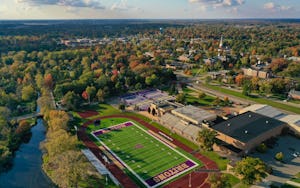SAT scores needed to get into Spring Arbor University
Average Score and SAT Requirements
Average SAT Score 1050
The average composite SAT score for admitted Spring Arbor University freshman is 1050 out of 1600. For perspective, a 1050 is in the 49th percentile of all SAT test takers.
SAT Score Range 935 to 1165
The middle fifty percent of incoming students have SAT composite scores ranging from 935 to 1165. The 75th percentile score is 1165 while the 25th percentile score is 935.
Minimum SAT score requirement
The lowest SAT score accepted is not reported by SAU but we estimate it to be around a 820 total composite SAT score.
Average SAT Math Score 517
The average score for SAU students on the math portion of the SAT is 517 out of 800. The 25th percentile of students score a 465 and the 75th percentile score 570.
Average SAT Reading Score 532
The 25th and 75th percentile range for SAT reading scores range from 470 to 595 and the average score for Spring Arbor University students is 532.
Number of Students Submitting SAT Scores
29 percent of students submit SAT scores with their application to Spring Arbor UniversityAdmission Chances by SAT Score
Below are estimated chances of being accepted at Spring Arbor University based on SAT score ranges and the overall admission rate of 37.3%. These chances assume you have an average GPA for the school, around 3.61.
Can I get into SAU with a 1165 SAT?
- Score competitiveness Very Good
An SAT score of 1165 or higher is very competitive at SAU and is a better score than three quarters of students who are accepted. You have an above average chance of acceptance, around 53% or higher.
Can I get into SAU with a 1050 SAT?
- Score competitiveness Above Average
Scores between 1050 to 1155 are above average giving you an advantage over most applicants. While scores in this range are higher than many who apply, admission is very competitive. The estimated chance of getting in is around 37% to 51%.
Can I get into SAU with a 935 SAT?
- Score competitiveness Below Average
SAT scores between 935 to 1040 are still in the middle range of accepted students a but a little lower than the average. You can get in and have about a 24% to 36% percent chance of being admitted.
Can I get into SAU with a 820 SAT?
- Score competitiveness Reach
SAT scores from 820 to 925 are on the very low end of the range where students are accepted. Scores in this range are not competitive with most other applicants but you still have a chance. We estimate scores in this range have less than a 23% chance of admission to SAU. SAT scores below 820 likely fall out of the range where students are regularly accepted.
Data Sources, IPEDS for Fall 2023 starting class| SAT Score | Admission Chances |
|---|---|
| 1600 | 93% |
| 1590 | 92% |
| 1580 | 92% |
| 1570 | 91% |
| 1560 | 91% |
| 1550 | 91% |
| 1540 | 90% |
| 1530 | 90% |
| 1520 | 89% |
| 1510 | 88% |
| 1500 | 88% |
| 1490 | 87% |
| 1480 | 87% |
| 1470 | 86% |
| 1460 | 85% |
| 1450 | 85% |
| 1440 | 84% |
| 1430 | 83% |
| 1420 | 82% |
| 1410 | 81% |
| 1400 | 81% |
| 1390 | 80% |
| 1380 | 79% |
| 1370 | 78% |
| 1360 | 77% |
| 1350 | 76% |
| 1340 | 75% |
| 1330 | 74% |
| 1320 | 73% |
| 1310 | 71% |
| 1300 | 70% |
| 1290 | 69% |
| 1280 | 68% |
| 1270 | 67% |
| 1260 | 65% |
| 1250 | 64% |
| 1240 | 63% |
| 1230 | 62% |
| 1220 | 60% |
| 1210 | 59% |
| 1200 | 58% |
| 1190 | 56% |
| 1180 | 55% |
| 1170 | 53% |
| 1160 | 52% |
| 1150 | 51% |
| 1140 | 49% |
| 1130 | 48% |
| 1120 | 46% |
| 1110 | 45% |
| 1100 | 44% |
| 1090 | 42% |
| 1080 | 41% |
| 1070 | 40% |
| 1060 | 38% |
| 1050 | 37% |
| 1040 | 36% |
| 1030 | 34% |
| 1020 | 33% |
| 1010 | 32% |
| 1000 | 31% |
Similar Colleges
Albion College
Private 4 Year
Cornerstone University
Private 4 Year
Grand Valley State University
Public 4 Year
Olivet Nazarene University
Private 4 Year
Ferris State University
Public 4 Year
Cedarville University
Private 4 Year
Primary data source, U.S. Department of Education https://nces.ed.gov/collegenavigator/?id=172334 IPEDS survey data for Spring Arbor University.





